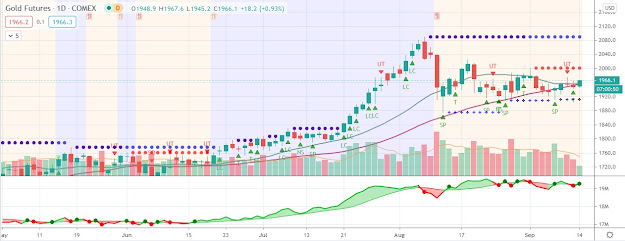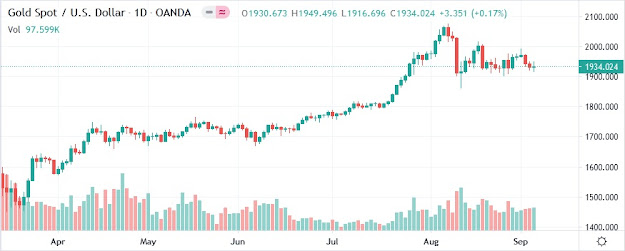Gold extended its weekly decline to 2.4% and reached its lowest level since January 18
The gold price came under heavy selling pressure Wednesday morning, falling $27.31, or 1.6%, to $1,643.63 per ounce. Coupled with the prior two days of losses, the price of gold extended its weekly decline to 2.4% and reached its lowest level since January 18. Silver declined in concert with the gold price, although by a smaller amount of 1.2% to $32.87 per ounce. The U.S. Dollar Index continued to climb, reaching its highest level since mid-January as well.
The gold price began the day by inching lower after the latest U.S. economic report showed a further improvement in the data. Retail sales for February rose by 1.1%, the largest increase in five months. Credit Suisse economist Jonathan Basile wrote in a note to clients that “This is a pleasant surprise on the overall picture for the economy. For the Fed, it’s steady as she goes. They will be encouraged, but there is still a long way to go.”
The encouraging retail sales data confirmed the Fed statement’s assessment of the economy – in particularly, where it noted that “household spending and business fixed investment have continued to advance.” The Fed also pointed out that “labor market conditions have improved further,” although the unemployment rate “remains elevated” and the “housing sector remains depressed.”
Based on its assessment of the economy, Chairman Bernanke and the Federal Open Market Committee (FOMC) chose to continue with Operation Twist and reiterate the need for near-zero interest rates through late 2014. As expected, the Fed did not launch a third round of quantitative easing (QE3). The decision included one dissenting vote – by Richmond Fed President Jeffrey Lacker – who took a more hawkish stance than during his dissent at the previous Fed meeting. In January, Lacker preferred not to specify the time period for near-zero interest rates, while now he disagreed with the need for “exceptionally low levels of the federal funds rate through late 2014.”
Commenting on the Fed meeting, Jan Hatzius – chief U.S. economist at Goldman Sachs – wrote in a note to clients that “On net the FOMC statement is very close to our expectations as the FOMC upgrades its description of the economic outlook, acknowledges the impact of oil prices on inflation, and softens (but retains) the ‘significant downside risks’ phrase.” While Hatzius did not discuss the implications for the gold price, the combination of the absence of QE3 and declining risk aversion in the markets put considerable pressure on the yellow metal. Although the Fed stated that “expects to maintain a highly accommodative stance for monetary policy,” the gold market was clearly disappointed by the moderately less dovish tone emanating from the U.S. central bank.
The gold price began the day by inching lower after the latest U.S. economic report showed a further improvement in the data. Retail sales for February rose by 1.1%, the largest increase in five months. Credit Suisse economist Jonathan Basile wrote in a note to clients that “This is a pleasant surprise on the overall picture for the economy. For the Fed, it’s steady as she goes. They will be encouraged, but there is still a long way to go.”
The encouraging retail sales data confirmed the Fed statement’s assessment of the economy – in particularly, where it noted that “household spending and business fixed investment have continued to advance.” The Fed also pointed out that “labor market conditions have improved further,” although the unemployment rate “remains elevated” and the “housing sector remains depressed.”
Based on its assessment of the economy, Chairman Bernanke and the Federal Open Market Committee (FOMC) chose to continue with Operation Twist and reiterate the need for near-zero interest rates through late 2014. As expected, the Fed did not launch a third round of quantitative easing (QE3). The decision included one dissenting vote – by Richmond Fed President Jeffrey Lacker – who took a more hawkish stance than during his dissent at the previous Fed meeting. In January, Lacker preferred not to specify the time period for near-zero interest rates, while now he disagreed with the need for “exceptionally low levels of the federal funds rate through late 2014.”
Commenting on the Fed meeting, Jan Hatzius – chief U.S. economist at Goldman Sachs – wrote in a note to clients that “On net the FOMC statement is very close to our expectations as the FOMC upgrades its description of the economic outlook, acknowledges the impact of oil prices on inflation, and softens (but retains) the ‘significant downside risks’ phrase.” While Hatzius did not discuss the implications for the gold price, the combination of the absence of QE3 and declining risk aversion in the markets put considerable pressure on the yellow metal. Although the Fed stated that “expects to maintain a highly accommodative stance for monetary policy,” the gold market was clearly disappointed by the moderately less dovish tone emanating from the U.S. central bank.




Comments
Post a Comment